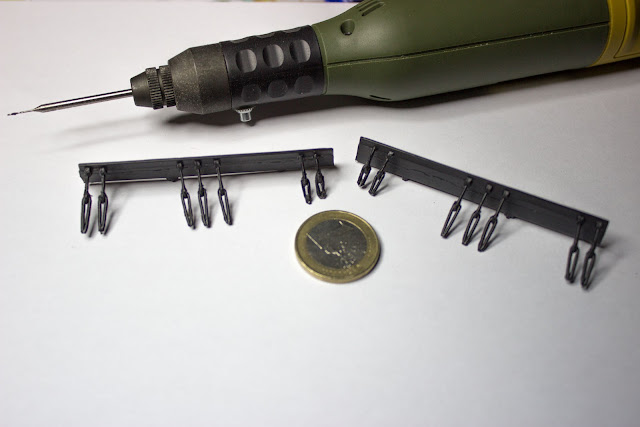Preparing the Bowsprit
Most of the pieces for the bowsprit are made of beige plastic, which, unfortunately for me, had a lot of casting problems (extra material, holes, etc.).
So the first step was cleaning the extra plastic, and filling the holes with putty.
For easier handling, I glued first the two halves of bowsprit and only then stared to clean it. Ideally, the two halves must be straight, however, they were bent and I needed to straighten them while gluing, and keep them in the right position. After the glue dried, I assembled the bowsprit cleats, before painting.
After all the pieces were cleaned...
... it was time for painting them.
Assembling the Bowsprit
At this stage, with all the pieces prepared, I started to build the bowsprit without assembling it on the ship yet, allowing me a more convenient handling.
I started with two more eyebolts glued on the dolphin striker:
... and then gluing the dolphin striker on the main bowsprit
... followed by jib-boom
... and then the flying jib-boom
Mounting the Bowsprit
I decided to mount the bowsprit on the ship before gluing the sail yard and performing the structural rigging, to avoid damaging the assembly. I knew that fitting the bow in the designated hole might require some convincing force and hole adjustments, which actually happened.
Having the bowsprit in place, I sealed the finished the assembly by mounting the bowsprit box
... and the final look before some structural rigging
Minimal Structural Rigging
There are several threads that need placing at this stage, to tighten the structure. I started taking care of the ropes that secured the jib-boom to the bowsprit. Using the small diameter thread, I made several loops around the two pieces, having them tensioned by attaching some weight, and then dropping some glue to secure the loops. Finally, I made some knots, secured with glue, too, and, once everything dried, I cut the excess threads off.
Next step was to mount the sprit sail yard, and rig it to the spritbow. I used the same procedure (making the loops, tensioning them using weights, drop glue, making final knots and then cutting the excess threads off the knots).
The final look on bowsprit small riggs:
Gammoning the Bowsprit
For gammoning I needed to use large diameter thread, extensively using tweezers to fit the threads through the small holes in head timbers and through the gammoning hole.
One of my favorite tool while rigging is (and will be) the one used to pull the thread through a needle. I know that from this moment on, I will have to use it a lot.
Before making the frapping turns, I tensioned the loops with weights and I secured them using glue.
Once the glue dried, I made the frapping turns and secured them with a double knot, glued.
























































































